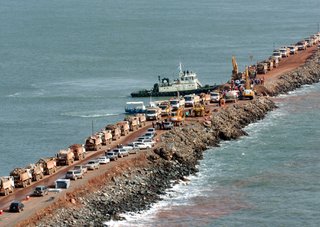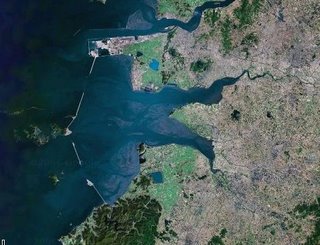
The above photo, posted in the Joongang Ilbo on Saturday, April 22, is followed by this caption:
The final section of the 33-kilometer (20.5-mile) embankment for the Saemangeum reclamation project was filled in yesterday. The goal of the project, on Korea's southwest coast, is to form a tidal flat of 28,300 hectares (69,930 acres) for rice production and tourism. Some 60 meters are left to seal the water inside.More photos of this moment can be found here, while a television report filled to the brim with thrilling, earth-moving images (and half a dozen "Mansei!"s) can be found here. It has not been smooth sailing for this project, due to the objections of environmental groups who point to the Saemangeum mud flats as supporting some of the largest and most important concentrations of migratory birds in Asia; with the completion of the wall, the mudflats will be freed of these seasonal visitors “in due course”. The most comprehensive presentation against the project can be found at this website. Their unhappy response to the completion of the sea wall can be found here, while a (small) video is shown here.
More on the history of the project (and the opposition to it) can be found in this article:
Initiated in 1991, the Saemangeum Project was aimed at turning 40,100 hectares of mudflats in coastal areas some 250 kilometers southwest of Seoul into 28,300 hectares of farmland and a freshwater lake by building a 33-kilometer seawall to seal off the mouths of the two rivers running through the area.

This is what the seawall looked like a few years ago. It’s worth noting that at 40,000 hectares (or 400 square kilometers), it’s two-thirds the size of Seoul. The article continues:
In August 2001 environment civic groups filed an administrative suit against the government demanding the nullification of the project. In July 2003 the Seoul Administrative Court ordered the temporary suspension of the controversial project until a court decision determined its future. But seven months later, it decided to let the reclamation of Saemangeum continue […]In February, 2005, the court ruled that further construction of the sea wall (to close the remaining 2.7 km stretch) should be halted. According to this article,
On Nov. 12 [2004] the Seoul Administration Court held a final public hearing on the nullification suit, hearing final opinions on the project from civic groups and the government.
They listed the following reasons to support their ruling to change or cancel the original permit:The government took the case to the Seoul High Court, which overturned this decision in December 2005, and allowed construction to resume.
• the possibility of using land reclaimed through the project for agriculture is very low
• it is anticipated that the water quality in the reclamation reservoir will be too poor to use for agriculture
• estimates of economic benefits to be derived from converting the existing area to agriculture are flawed
• massive damage will be caused to the tidal-flat ecosystem.
Now that the wall has been completed, the government still insists it will use the area for farming, as well as for creating parks, though it hasn’t finalized plans yet.
If you’re curious as to what the government and developers may have in mind, you need look no further than this website. There are numerous photos to be found there, such as the one below.

Care to look into some farmland there? Perhaps this real estate agency can help. If you’re still not finding yourself excited over this, you need to get pumped up by this video!
Perhaps you need more than videos and photos to be convinced that this is a good idea, and that it won’t cause a great deal of environmental damage. Will photos of birds on main webpage (linked to above) do?

If even this does nothing to help, and you’re still skeptical of such transparent corporate propaganda, then the only thing left is to show you is something that is simultaneously hilarious and creepy - this little piece of opinion engineering in the form of a comic strip:

Now, in truth, that is not what the father duck says in that panel in the original version, but it does communicate the essence of this little piece of corporate propaganda. Seriously – it’s like one of those boring documentaries the kids are forced to watch on The Simpsons, except that it isn’t a joke. The father duck (who has obviously had a few cake boxes sent to him by the developers) tells junior that Korea has a long history of reclaiming coastal land, pointing to the reclamation that enlarged Ganghwa Island in the Goryeo period (strange that he didn’t mention the 1994 Lake Shihwa reclamation project, which failed for the same reasons environmentalists believe Saemangeum will), and then talks about how they’ll be able to feed 1.5 million more people (“Like North Koreans”), how the wall will become a freeway making travel between Buan and Gunsan much, much faster than it is now on the nearby (already existing) expressway, and how it’s going to become a wonderful tourist area with its large freshwater lake.
You can check out this woefully transparent (yet perhaps for that very reason, oddly amusing) piece of propaganda here.

2 comments:
Interesting to see how environmentalism and nationalism/friendship with the North collide in this particular issue.
Yeah, why do I get a feeling it won't be used for agriclture all that much? There's already agricultural overproduction, and I doubt the developers are going to be happy waiting until more farmland is actually needed.
Post a Comment